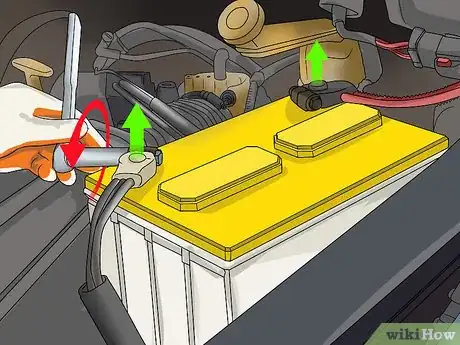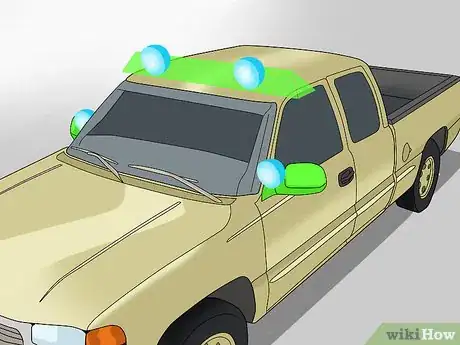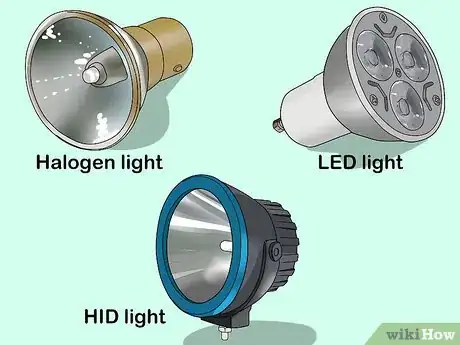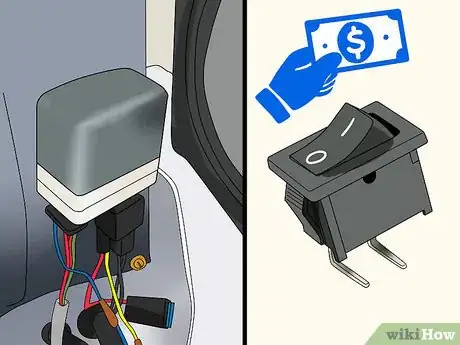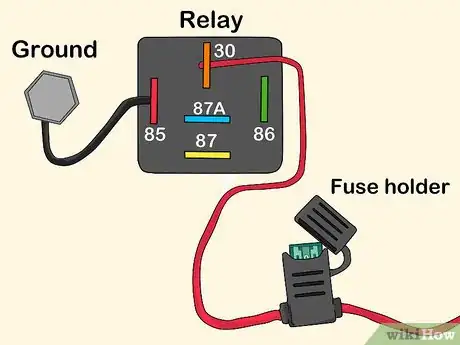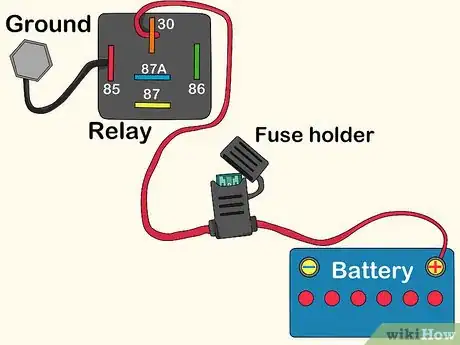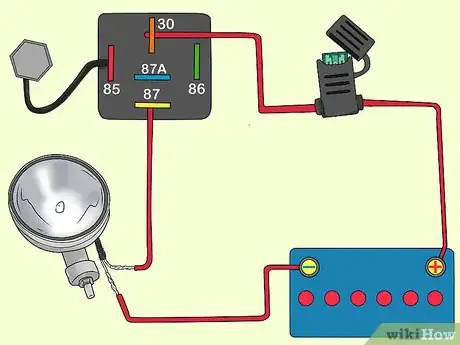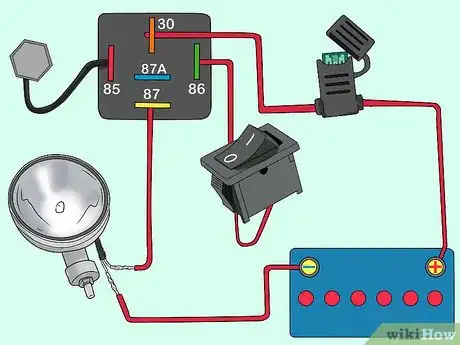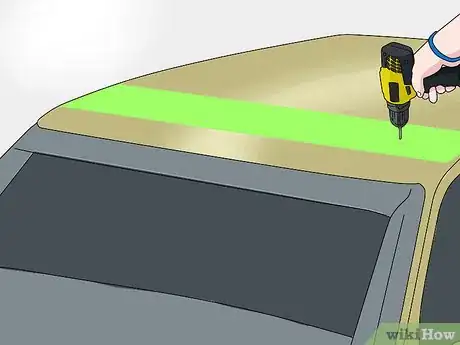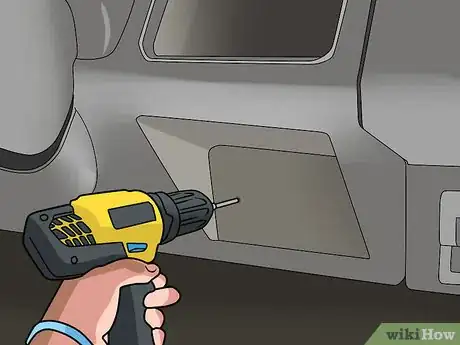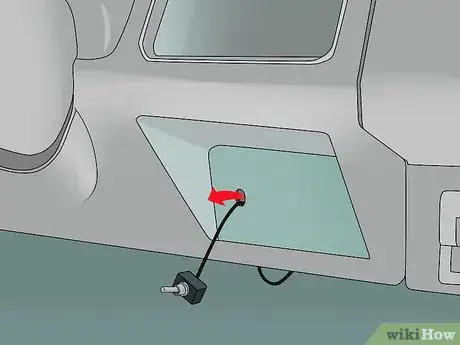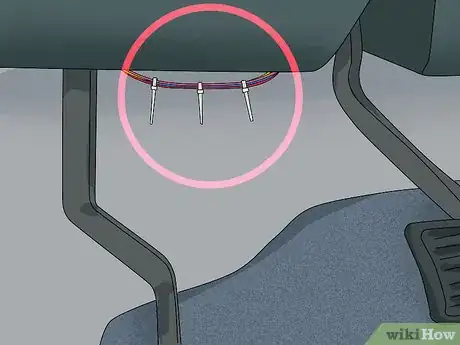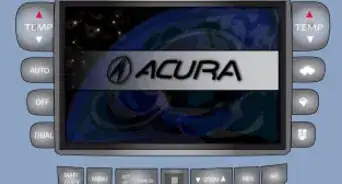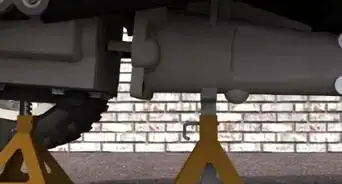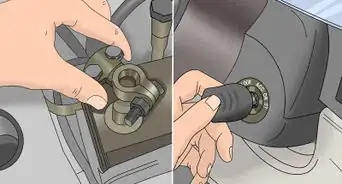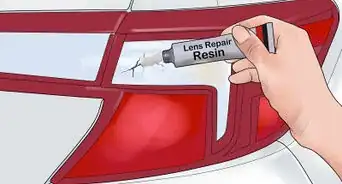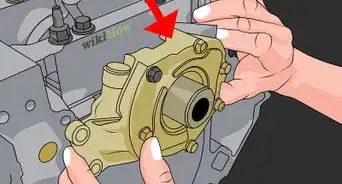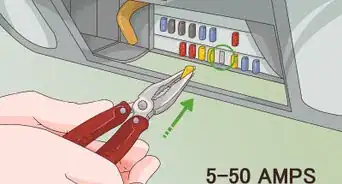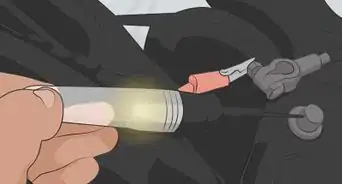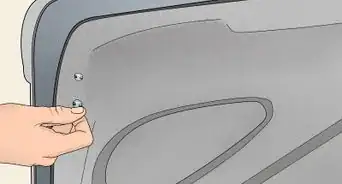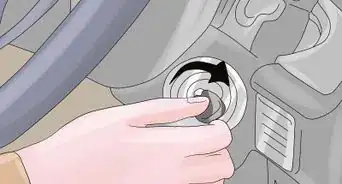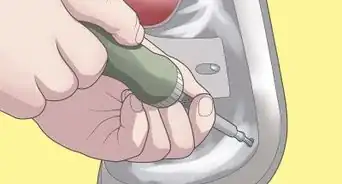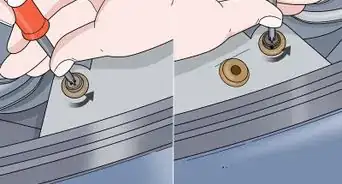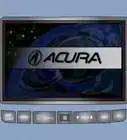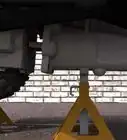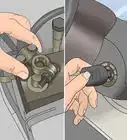This article was co-authored by wikiHow Staff. Our trained team of editors and researchers validate articles for accuracy and comprehensiveness. wikiHow's Content Management Team carefully monitors the work from our editorial staff to ensure that each article is backed by trusted research and meets our high quality standards.
This article has been viewed 301,352 times.
Learn more...
Installing a spotlight on your vehicle can improve your ability to see the ground when driving off road or increase visibility in low light conditions. It’s important to note that using a spotlight on public streets is illegal in many areas, so check the laws in your region before installing a spotlight for use while driving. While some spotlights can be installed without the use of a relay, it is still recommended that you utilize one for optimal performance.
Steps
Planning Out Mounting Locations
-
1Disconnect the battery. Before working with the electronic system in your vehicle, it’s important to disconnect the battery to avoid shocking yourself or doing any damage. Open the hood and use a hand or socket wrench to loosen the nut holding the black ground cable on the negative terminal on the battery. Once loose, pull the cable off and tuck it to the side of the battery to avoid allowing it to come back into contact with the terminal.[1]
- The negative terminal can be located by looking for the letters “NEG” or the negative symbol (-) on the battery.
- You will not need to disconnect the positive cable.
-
2Choose a suitable mounting location. There are a number of places one could feasibly mount a spotlight, so choose a location that’s best for your purposes. Some common locations include on top of your side mirror or on the roof of the vehicle.[2]
- You will need to identify the location you intend to mount the spot light first in order to cut the proper lengths of wire.
- Remember that if you install the spotlight on your roof, you will have to drill through it, which may cause leaking.
Advertisement -
3Decide what type of light to use. There are a number of options on the market for spotlights and installation kits. The three common types of spotlights you can purchase are halogen, LED and HID. Each style of light has its own strengths and weaknesses and should be chosen based on application and budget.[3]
- Halogen lights will be the cheapest and usually the dimmest. However, the bulbs are less expensive to replace when they blow out.
- LED lights can be extremely bright and cost more than most halogen spotlight applications.
- HID lamps are the most expensive, but offer the longest lifespan and often the brightest lights.
-
4Determine where you want to place the switch. You may decide to install a button or switch inside your vehicle to turn the spotlight on and off. On many spotlights, the switch will be on the light itself and will require no further wiring. If you opt to wire the light to a switch on your dashboard, however, the installation will be a bit more in depth. If you decide to run a switch for a light that has one on the light, leave the switch on the light set to “on.”[4]
- Even if the light has a switch, you may still choose to run a switch into your vehicle.
- Determining where you want the switch will help you establish how much wire the project will require.
Wiring the Spotlight Using a Relay
-
1Mount the relay in the engine bay. If your spotlight did not come with an electrical relay, you will need to install one. Most stoplights should not be wired directly to a power source without being run through a relay. If your kit did not come with one, purchase a SPST (Single Pole Single Throw) Relay from your local auto parts store. Mount it inside your engine bay somewhere along the body of the vehicle.[5]
- Try to avoid mounting the relay too close to the exhaust manifold, as the heat may damage the relay.
- You can use heavy duty double sided tape, an adhesive, or drill holes through the metal to mount the relay.
-
2Ground the relay. Run a short length of black wire from the relay to a bolt on the body or frame of the vehicle. Expose a length of wire at the end and make a loop with it, then loosen the bolt and loop the exposed wire around it below the head. Twist the wire around itself to secure it to the bolt, then tighten the bolt again.[6]
- This wire will provide the ground for the relay circuit.
- Whenever possible, use black wiring for grounds to make them easy to identify.
-
3Run a wire from the relay to an in-line fuse. Purchase an in-line fuse holder and connect it to the positive post on the relay. You may need to run wire from the positive post to the in-line fuse holder if it can’t connect to it directly. Make sure there is a fuse in the fuse holder rated to withstand the amperage required to power the spotlight.[7]
- This fuse will protect the spotlight and the relay from surges if there is an issue with your electrical system.
- The fuse will blow out if too much power flows through it, cutting the power and preventing a fire.
-
4Connect the fuse to the positive terminal on the battery. Run a length of wire from the fuse holder to the positive terminal on the battery. You may choose to wrap a length of exposed wire around a bolt on the battery cable, or you may choose to purchase a new Positive cable end. If you do so, insert the end of the positive cable as well as the wire from the relay’s fuse into the end, then use pliers to compress the cable end until the wires are held securely in place.[8]
- This wire will provide the power to the relay, and then the spotlight itself.
- Ensure the cable to securely fastened to the positive terminal. If it jostles loose, the spotlight will fail to function.
-
5Wire the relay to the positive post on the spotlight. Run a wire from the relay to the positive post on the spotlight itself. You may choose to twist the wire around the positive post or solder it into place. Regardless of how you connect the wiring, be sure to wrap it in electrical tape or a shrink wrap sleeve to protect the connection from the elements.[9]
- Soldering the wire is the strongest and most permanent way to connect the wiring to the spotlight.
-
6Run a wire from the relay to the switch. Run a wire from the last open post on the relay to the switch in your vehicle if you choose to mount one. This will enable to the switch to cut the power to the spotlight. You may be able to run the wire through a hole in the firewall of your vehicle on the driver’s side. This will make the wire come out near the pedals inside the cabin.[10]
- If you are unable to run the wire through the firewall, tuck it through the corner where the hood, fender and driver’s side door meet.
- Be careful not to run the wire through anything that may melt or break it in the regular use of your vehicle.
Mounting the Wired Components
-
1Drill the mounting holes for the spotlight. Use the hardware supplied in your spotlight kit to mount the light in the location of your choosing. If it was designed to be mounted on your roof, it may have come with a strip of weather proofing material to prevent water from leaking through your roof where the holes are drilled. If it did not, you may want to put silicone in and around the holes as you bolt the light into place to create a waterproof seal.[11]
- If you choose to mount the light on your mirror, you will not need to use any weather proofing.
- Mounting a spotlight on a light bar or otherwise attached bracket will also require no drilling or weather proofing.
-
2Mount the switch in the dashboard. Secure the switch on your dashboard in place by drilling a hole through the trim and sliding the switch through it from behind. This will leave only the switch visible, with the rest behind the trim. Place the screw on cap over the switch, with the switch itself sticking out through it, then screw it in place to hold the switch against the trim.[12]
- If you choose to use a button instead of a switch, it will mount in the same way.
- Ensure the switch is someplace easy to access without looking to be able to use the light while you drive.
-
3Ground the switch. Run a black wire from one of the three prongs on the switch to a bolt on the body or frame of the vehicle just as you grounded the relay under the hood. Make a loop with the exposed end of the wire and wrap it around a bolt. Tighten the bolt back into place once completed.[13]
- The switch needs its own ground and power source to function properly.
-
4Run a wire from the switch to a switched power source. Locate the fuse box on the driver’s side of the cabin of your vehicle. Identify a fuse that powers an electronic device that only functions when the vehicle is running, such as the radio, headlights or turn signals. Remove the fuse and insert and “add-a-circuit” or standard blade fuse holder with a wired pigtail hanging off that you can connect the wire from the switch. This will prevent the spotlight from working when the vehicle is not running.[14]
- Be sure to put a fuse in the fuse holder to power the switch.
- Check the instructions for the spotlight and ensure you use a fuse rated for the amperage needed for the light to function.
-
5Tuck up and secure the wiring. With everything wired, reconnect the battery and tuck the wiring away so it isn’t visible. Use zip ties under your dashboard to secure any extra wire up beneath the dash so you can’t accidentally catch it with your feet or a pedal. Run any wiring on the exterior of your vehicle along edges until you can tuck it under or between panels of the body to keep it from being visible.[15]
- Reconnect the battery and test your new spotlight.
- If the light fails to turn on, ensure none of the wires have been pulled off their terminals or been crimped to interrupt the flow of electricity.
Community Q&A
-
QuestionWhat type of wire do I need?
 Community AnswerDepending on how far you need to run the wire and what amperage the light is designed to operate at, it is recommended that you use a minimum of 12 gauge wire. In some applications, 10 gauge may be more appropriate.
Community AnswerDepending on how far you need to run the wire and what amperage the light is designed to operate at, it is recommended that you use a minimum of 12 gauge wire. In some applications, 10 gauge may be more appropriate. -
QuestionWhat if I don't want switch and just want to run spotlights with the lights on my car, how do I do that?
 Community AnswerMost countries require a separate switch to isolate spotlights when you are using high beam. Not a good idea to have spots come anytime your lights are on.
Community AnswerMost countries require a separate switch to isolate spotlights when you are using high beam. Not a good idea to have spots come anytime your lights are on. -
QuestionWhy can't I fit the spotlights directly on the battery?
 Community AnswerIf you have a power surge, it will blow your equipment or possibly melt wires/fuses.
Community AnswerIf you have a power surge, it will blow your equipment or possibly melt wires/fuses.
References
- ↑ http://www.fourwheeler.com/how-to/electrical/131-0906-off-road-hid-headlight-wiring/
- ↑ http://www.popularmechanics.com/cars/how-to/a10124/how-to-install-your-own-driving-lights-16543999/
- ↑ http://www.popularmechanics.com/cars/how-to/a10124/how-to-install-your-own-driving-lights-16543999/
- ↑ http://www.popularmechanics.com/cars/how-to/a10124/how-to-install-your-own-driving-lights-16543999/
- ↑ http://www.popularmechanics.com/cars/how-to/a10124/how-to-install-your-own-driving-lights-16543999/
- ↑ http://www.therangerstation.com/tech_library/relays.html
- ↑ http://www.therangerstation.com/tech_library/relays.html
- ↑ http://www.therangerstation.com/tech_library/relays.html
- ↑ http://www.therangerstation.com/tech_library/relays.html
- ↑ http://www.therangerstation.com/tech_library/relays.html
- ↑ http://www.fourwheeler.com/how-to/electrical/131-0906-off-road-hid-headlight-wiring/
- ↑ http://www.fourwheeler.com/how-to/electrical/131-0906-off-road-hid-headlight-wiring/
- ↑ http://www.fourwheeler.com/how-to/electrical/131-0906-off-road-hid-headlight-wiring/
- ↑ http://www.fourwheeler.com/how-to/electrical/131-0906-off-road-hid-headlight-wiring/
- ↑ http://www.therangerstation.com/tech_library/relays.html
About This Article
To install spotlights on your vehicle, begin by disconnecting your car battery at the negative terminal. Mount the relay inside the engine bay with heavy duty double sided tape or by drilling holes through the metal. Then, run one wire from the relay to a bolt on the body of the vehicle to ground it, and a second wire from the relay to the in-line fuse. Securely connect the fuse to the positive terminal on the battery with a third wire to provide power to the relay and the spotlight itself. Then, run a fourth wire from the relay to the positive post of the spotlight and solder in place. The fifth wire should connect the last open post on the relay to the switch. Drill holes to mount the spotlight and light switch in your preferred locations. To ground and power the light switch, run one wire from a switch prong to a bolt on the body of the vehicle, and run a second wire to the fuse box on the driver’s side. Finish by reconnecting the battery and tucking away any visible wiring. For more details on how to install spotlights, scroll down!
